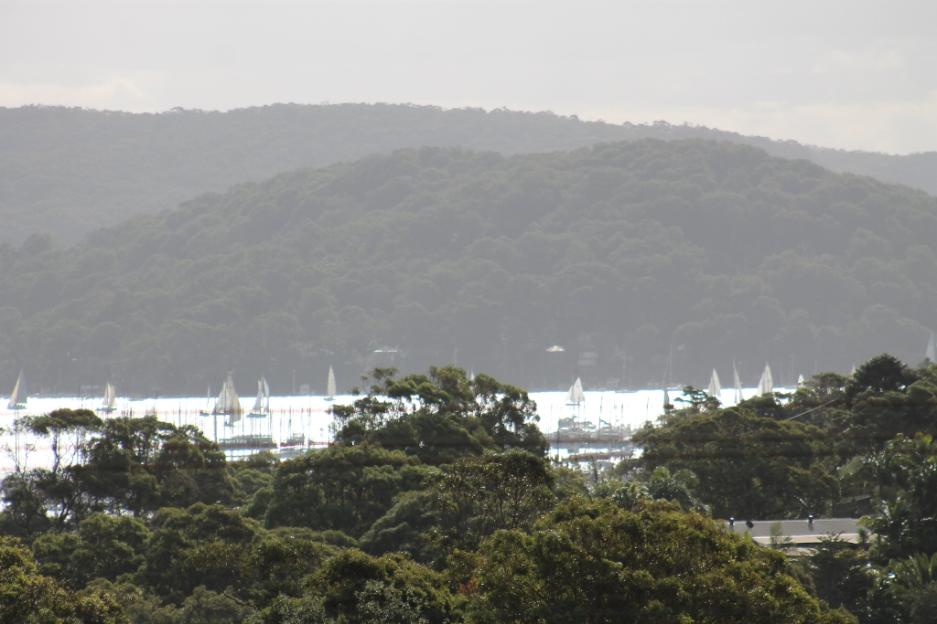John Gordon
1927 - 2021
VALE JOHN GORDON
1927-2021
It is our melancholy duty to inform this community of the passing of John Gordon on Monday, January 25th, 2021.
A member of the Mona Vale Hospital Auxiliary, the gentleman who taught many of our premier sailors ‘how to’ and invested many other decades in Sailability at the behest of Kay Cottee, John Gordon also spent time on land. A pursuit of science, a lifelong passion for chemistry and geology led to serving on the N.S.W. Heritage Council for restoration works to sandstone.
As an 18 year old he sailed in the Inaugural Sydney to Hobart yacht race. John also served as one of the inaugural lecturers in Geology when Australia was scarce of teachers in this department.
Our condolences to Eileen and family members.
The community treasures the memories of this 'salty dog' of Pittwater.
Below runs his Profile from 2013 as a Tribute to a wonderful gentleman.
John Gordon
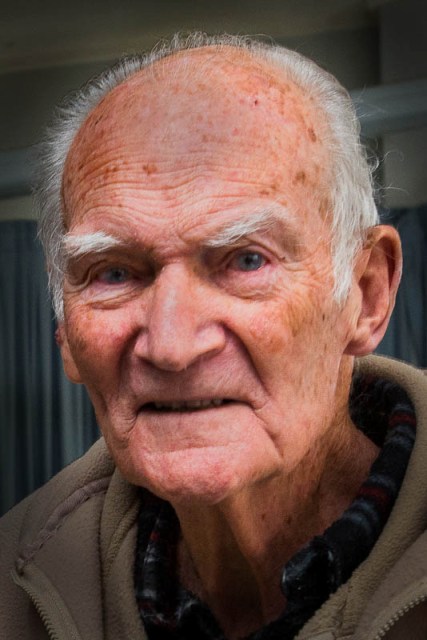 Honest Long John Gordon is the moniker this gentleman is known as up and down Pittwater: “If you want my opinion, ask it; if you don’t like it, that’s fine, we will agree to disagree. We will shake hands and then go to the bar, together, for a drink.”
Honest Long John Gordon is the moniker this gentleman is known as up and down Pittwater: “If you want my opinion, ask it; if you don’t like it, that’s fine, we will agree to disagree. We will shake hands and then go to the bar, together, for a drink.”
A member of the Mona Vale Hospital Auxiliary, the gentleman who has taught many of our premier sailors ‘how to’ and invested many other decades in Sailability at the behest of Kay Cottee, John Gordon has also spent time on land. A pursuit of science, a lifelong passion for chemistry and geology has led to serving on the N.S.W. Heritage Council for restoration works to sandstone.
What you may not know is that as an 18 year old he sailed in the Inaugural Sydney to Hobart yacht race or has served as one of the inaugural lecturers in Geology when Australia was scarce of teachers in this department. Has he seen a few changes ? Definitely!
This week it is our great privilege to share a small insight into another Pittwater legend, John Gordon.
When and where were you born?
86 years ago; last century (1927). I was born under the guns at Middle Head. My father was the Battery Sergeant. I don’t remember this but he then moved to South Head and he was Battery Sergeant that put the first gun in at North Fort.
Where did you grow up?
I grew up in Watson’s Bay, at Camp Cove. The landscape was very similar to what it is today because it has been preserved as a Historic site. I grew up around there before WWII; we lived in barracks until 1938 when dad retired and left the Army. My mother died in 1933, I still remember her. I had a dear old grandma; I was brought up with a good old Irish-Scottish background. Gordon being Scottish, that’s our clan, but my mother’s name was Kelly.
When dad got out of the Army we lived in North Sydney and then we lived in Homebush. This was the late 1930’s.
What was Homebush like in the late 1930’s?
We lived in Homebush West, which was rural then. The nearest station was at the end of the street at Flemington. This was the main Western Railway; the fish and chips, the Blue Express went through there. I grew up near the sale yards so I had a rural background while there. I then lived in Bondi as a teenager. This was a good place, we lived just up from the beach. I was in the North Bondi Surf Club as a junior.
Where did you go to school?
I went to school at Flemington and then I got a scholarship to Christian Brothers School in Lewisham. There were three scholarships and only two blokes got them.
I then got a bursary of my sixth class to go to boarding school at St John’s College in Woodlawn. My auntie, who was a teaching nun, organised this but it was a bit too far away. My dad had bought a place in Lewisham so I went to the Christian Brothers there and then off the Intermediate, the old Intermediate, I got a bursary to Christian Brothers College at Goulburn; so I was brought up by the Christian Brothers. I was at boarding school at Goulburn for three years, for the final three years of High School. I lived with my grandmother until she died and then with my auntie at Homebush.
What did you did when you finished school?
I always wanted to muck around with chemicals. I had a good Chemistry Master and the first job I got, my father got it for me as he was quite friendly with Elliot’s, an Australian owned drug company, was an apprenticeship there to do Pharmacy. I got another scholarship in order to be able to do this. See my father, being ex-Services from WWI and then WWII, and being an orphan so to speak, you made a good case for getting a good education, and thank God I got a good education. But I wasn’t successful as a Pharmacist.
I have a number of qualifications and one of these is Ph.C and that’s a Pharmaceutical Chemist, they’re the blokes that wear the white coat. I was a Ph.C failed with Honours. I failed the Pharmacy Board’s exam so I could work in the Pharmacy at Elliot’s, a beautiful pharmacy, but I couldn’t run my own shop.
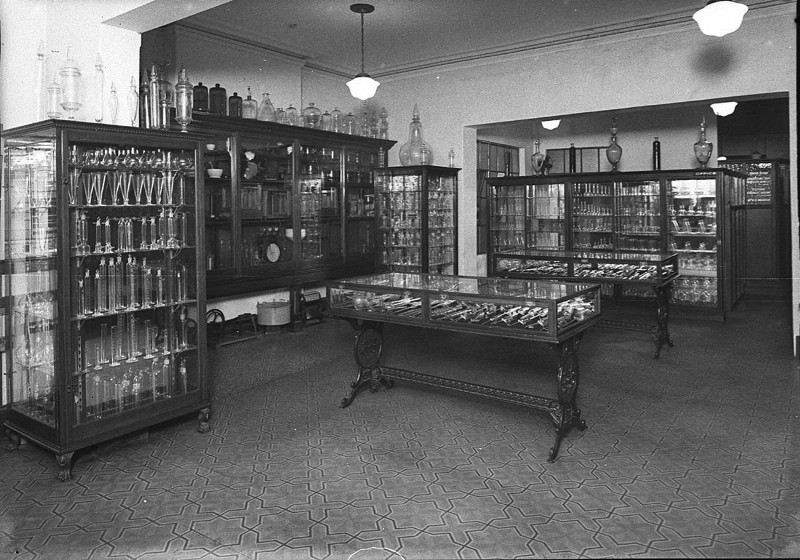
Elliotts Brothers Limited was the premier manufacturer of drugs, chemicals, surgical equipment and tonics from the mid 1880’s. Although the company became Elliott Brothers Limited amalgamated with several other Australian pharmaceutical companies to create Drug Houses of Australia in 1930, the pharmacy in York street and building in O’Connell street Sydney still went by this name. Photo: Interior, Elliott Brothers, 131 York Street, Sydney, N.S.W., 1936. Image No: hood_23204, courtesy State Library of NSW.
A job came up, and being adventuresome, I got a job in Malaysia working on the tin dredges from where Penang is; if you go on the railway up from Singapore, go right through to the border, a place called Ipho - it was British-Malay tin and they are still big tin producers, they’re world famous. So I got a good job there working on the tin dredges surveying where the tin was going to run, I was a prospector but then got bad malaria. I was pensioned off, came back home and worked for a couple of chemical companies. I then got a job at Sydney Technical College as a bottle washer First Class – a Lab Attendant. I’ve written my memoirs, I haven’t published them, and they are called ‘From Lab Boy to Lecturer’.
In my professional work over the years I was on the N.S.W. Heritage Council Environment Restoration Committee. With George Gibbons we worked on every Historic public building in sandstone in Australia bar one or two. Sandstone was my thing. I have a geological background; I’d grow roses and rocks; I’ve got rock gardens and Eileen is the gardener; I dig the holes where she tells me to.
I have three very important buildings in town which I’m an adviser on and my fee to go into town is all expenses covered and one bottle of a top port. The three buildings I have an involvement in due to being originally involved in their restoration are Saint Andrews, Sydney Town Hall and the QVB.
I’ve always had a great interest in rocks and geology. I did some work in Kuring-gai National Park on the aboriginal carvings. I’m an Honourary Ranger, every 12 months I have to apply for my card, and I occasionally take groups through to look at the aboriginal carvings (Petroglyphs). That was a project Dr. George Gibbons and I did with Sydney University and Australian Museum.
Which is your favourite out of all those you’ve seen and helped with restorations?
The Sydney Town Hall. They’ve been doing work to clean it lately; you’ll see covers over it. I worked for my good friend and boss, Dr. George Gibbons, all our technical papers are under the name ‘Gibbons and Gordon’. We were the sandstone specialists for Australia.
So you went all over Australia doing that?
Yes. I was lucky to get a six months scholarship in Europe through the Building Research Establishment of CSIRO to do particular wok on planning and restoration for sandstone buildings and I learnt a lot. I had three months in the UK, England, Scotland and Wales and three months on the continent. My favourite building there was the stage three of the Cologne Cathedral.
I started my diploma at the Tech, that’s where I met my dear wife. I got a job teaching there and we were taken over by the University of Technology which was the University of NSW. With my geological and chemical background, and I had an assayers ticket, I got a job in the Metallurgy school at Kenso and from there I came back to teaching at the Tech. The University of Technology was then set up or formed into a University from the NSW Institute of Technology. I worked with them in the chemistry department, which was my strongpoint, but I also had geology and when they founded the Wyndham Scheme, they found out most of the teachers in the schools had no geology background. They all were biologists, and they still are. They suddenly had 98 students banging the doors down, mainly teachers among them, and no one to teach geology.
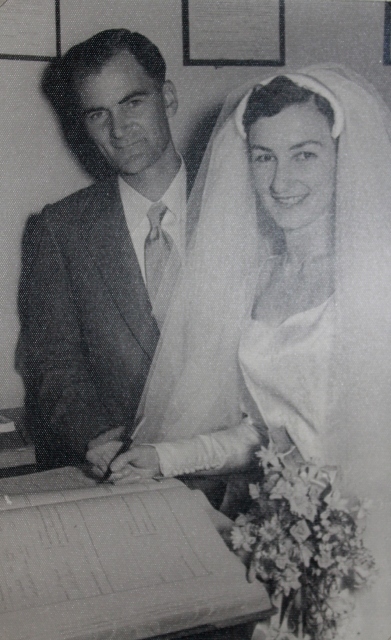 Born in rural Australia, Dr Harold Wyndham became Director-General of Education in New South Wales in 1952, the first ‘academic’ to hold the post. Wyndham’s greatest achievement was to conceive, propose and then implement the ‘Wyndham Scheme’ for comprehensive education in New South Wales. He built upon earlier proposals formed in Australia and overseas, but the ideas were mostly his own. The Wyndham Report was a slim volume designed for public consumption which proposed a universal secondary school designed for all abilities, rather than different schools for different abilities. The scheme took more than a decade to implement. Since then changing social expectations and political priorities have undermined Wyndham’s ideal of the public comprehensive school based on local neighbourhoods, but it still remains one of the most important experiments and ideals in the history of Australian education. From University of Sydney website.
Born in rural Australia, Dr Harold Wyndham became Director-General of Education in New South Wales in 1952, the first ‘academic’ to hold the post. Wyndham’s greatest achievement was to conceive, propose and then implement the ‘Wyndham Scheme’ for comprehensive education in New South Wales. He built upon earlier proposals formed in Australia and overseas, but the ideas were mostly his own. The Wyndham Report was a slim volume designed for public consumption which proposed a universal secondary school designed for all abilities, rather than different schools for different abilities. The scheme took more than a decade to implement. Since then changing social expectations and political priorities have undermined Wyndham’s ideal of the public comprehensive school based on local neighbourhoods, but it still remains one of the most important experiments and ideals in the history of Australian education. From University of Sydney website.
The Institute of Technology had taught Chemistry, Biology, Physics and Maths and the sore thumb, Geology, wasn’t there. My boss knew my background, I was doing a higher degree at the time, said ‘you’re it, we need someone to set up a Geology Course for these people’. So I was the foundation teacher and was due to be promoted and sent to Wollongong but I didn’t want to go to Wollongong. We’d just bought our block of dirt here (in Mona Vale) and we had built our beach shack. We are still, after 54 years, living in our beach shack.
I ended up Senior Lecturer after 36 years of working here, there and everywhere, including having a stint with the Geological Survey because I graduated in Geology and Biology with my Diploma but with my degree I always liked Chemistry and I graduated as a Geo-Chemist. Straight pass for me– Eileen’s the genius of the family.
Where did you meet Eileen?
At Tech. She was a student and I was six years older then her. In the classes we were in in the early stages of Science, she graduated a year before me, with an Honours Diploma mind you, there were three girls in a class of one hundred.
She must have been pretty bright.
She was, she was. People say, “well why did she marry you?” but we’ve stuck together for 56 years!
You were in the Army Reserves too, how did that occur?
.jpg?timestamp=1373732837975) I was in the Army Reserve for years. I was in the Army Reserves in 1950 when you didn’t have to, but as I had an Army background. I joined in infantry, as a private soldier, much to my father’s disgust as he finished up at Victoria Barracks as the regimental Master Sergeant, the top WWI A1 instructor. I ended up in the East Command Malaria Control Unit with my science background. In 1952, of the 92 of all ranks that went to Singleton Camp, there’s only five of us alive. Two of those chaps, and myself, are original members.
I was in the Army Reserve for years. I was in the Army Reserves in 1950 when you didn’t have to, but as I had an Army background. I joined in infantry, as a private soldier, much to my father’s disgust as he finished up at Victoria Barracks as the regimental Master Sergeant, the top WWI A1 instructor. I ended up in the East Command Malaria Control Unit with my science background. In 1952, of the 92 of all ranks that went to Singleton Camp, there’s only five of us alive. Two of those chaps, and myself, are original members.
I was a corporal and joined that as a sergeant, because they didn’t have any non-commissioned officers. I had to do a course in the camp, and spent years as the transport sergeant and went on and was promoted for efficiency to Brigade Headquarters. My plum posting was as a staff officer for Major-General Denzil Macarthur Onslow on the old Two Div. I served under him.
What was that like?
Fantastic. We were at Victoria Barracks in Sydney. I couldn’t get a commission because we were raised as an engineering unit and I didn’t have the technical paper. In fact my old transport sergeant when I got promoted to Brigade and he took over from me as Transport Officer, a top bridge player, is now a half Colonel.
What rank did you end up as?
On my shoulder; three pips; qualified, I was a Major, but I never wore the badges because our unit disintegrated. When Two Division finished, and National Servicemen had finished, I then got a posting as Camp Commandant, Eastern Command, Troops. Once a month I had to mount the guard with a bunch of scruffs who lived around the red light district there, but they were good diggers. My job was to knock them into shape. I never had a discipline problem. I remember my Sergeant-Major said to me “I’ve got four applications for permission not to do our annual camp” and that was unheard of. And I inquired why and it turned out they were all doing six months at Her Majesty’s Pleasure for knocking off cars; so that’s the mob I had! They were scallywags some of them! But it was good training for the Ocean Youth Club; all of it helped me help others.
You’ve done a bit of sailing too?
Sailing has been my hobby.
But you went in the first Sydney to Hobart yacht race, and have been in others since?
Yes, the first Sydney to Hobart yacht race was Boxing Day 1945. There are only two men alive today who sailed in that. The other man is Geoff Ruggles. He lives in Kiama. When this comes close each year I go and stay with him for a few days or he comes up and stays with me.
What was this first one like?
Bloody hard work. The name of the yacht was the Winston Churchill. Beautiful boat. The history of the Winston Churchill is a wonderful thing. I started my sailing as bailer boy in my father’s 18 footer on the harbour before WWII, and I bailed Sydney Harbour out at least twice. It was a good upbringing. I started in a VJ there and I’ve always been interested in sailing, it’s in my blood.
Bob Ross who founded Australian Sailing, a couple of other friends nominated me for anniversary celebrations. What came up was the 60th anniversary, the 50th anniversary was in 1994, so 2004 was the 60th and they looked around for anyone that was still alive and there were only six of us. One was the bloke who won it, Captain John Illingworth, his navigator was a Royal Navy lieutenant, Ray Richmond, and Ray was out here in Australia in 2004, so Ray, Geoff Ruddles and myself were the only three, Peter Luke was too sick. The three of us started the 60th rush; fired the cannons and all that sort of caper.
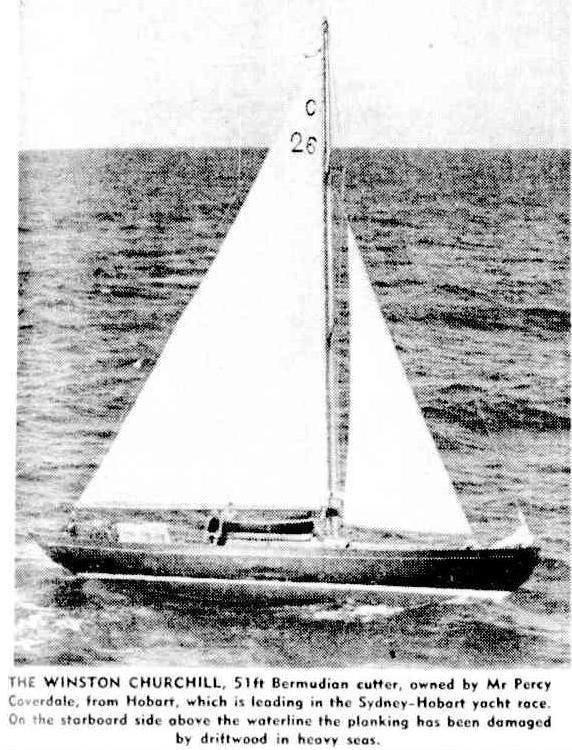 SYDNEY-HOBART YACHT RACE - CONSIDERABLE interest, not only in yachting circles but by the public generally, is being taken in the yacht race from Sydney to Hobart, which begins on Boxing Day. Ten entries have been received-eight from Sydney, and one each from Hobart and Melbourne. Tasmanians will follow closely the performance of Winston Churchill, P. Coverdale's fine 52ft. cruiser, which is one of the largest and fastest on the Derwent. Other boats, entered are Saltair, Archina II., Kathleen, Wayfarer, Mistral II., Morna, Rani, Ambermerle, all of Sydney, and Warrana from Victoria. With favourable weather the boats should reach Hobart in about a week. The Cruising Yacht Club of Sydney, which is conducting the race in conjunction with the RYCT, has arranged for a daily aerial reconnaissance to be made by the RAAF, which will report the boats' positions. The Royal Ocean Racing Club's yacht rating rule will be used to assess the results for the award of the trophies. The rule, which was drawn up as a result of many years of experience, equalises the chances of yachts of widely differing types and sizes. It makes allowance, among other factors, for high freeboard, heavy hull construction, deep hulls, bulwarks, and propellers. Boats of cruising type with short overhang receive a lower rating than similar size boats of racing form. Rig allowances are granted to ketches, schooners, yawls, and a gaff sail receives an allowance on a Bermudan sail of the same area. Trophies will be awarded to the first four boats to finish under the RORC rating, and a special prize will be given to the first yacht to finish irrespective of rating. SYDNEY-HOBART YACHT RACE. (1945, December 21). The Mercury (Hobart, Tas. : 1860 - 1954), p. 14. Retrieved from http://nla.gov.au/nla.news-article26154482
SYDNEY-HOBART YACHT RACE - CONSIDERABLE interest, not only in yachting circles but by the public generally, is being taken in the yacht race from Sydney to Hobart, which begins on Boxing Day. Ten entries have been received-eight from Sydney, and one each from Hobart and Melbourne. Tasmanians will follow closely the performance of Winston Churchill, P. Coverdale's fine 52ft. cruiser, which is one of the largest and fastest on the Derwent. Other boats, entered are Saltair, Archina II., Kathleen, Wayfarer, Mistral II., Morna, Rani, Ambermerle, all of Sydney, and Warrana from Victoria. With favourable weather the boats should reach Hobart in about a week. The Cruising Yacht Club of Sydney, which is conducting the race in conjunction with the RYCT, has arranged for a daily aerial reconnaissance to be made by the RAAF, which will report the boats' positions. The Royal Ocean Racing Club's yacht rating rule will be used to assess the results for the award of the trophies. The rule, which was drawn up as a result of many years of experience, equalises the chances of yachts of widely differing types and sizes. It makes allowance, among other factors, for high freeboard, heavy hull construction, deep hulls, bulwarks, and propellers. Boats of cruising type with short overhang receive a lower rating than similar size boats of racing form. Rig allowances are granted to ketches, schooners, yawls, and a gaff sail receives an allowance on a Bermudan sail of the same area. Trophies will be awarded to the first four boats to finish under the RORC rating, and a special prize will be given to the first yacht to finish irrespective of rating. SYDNEY-HOBART YACHT RACE. (1945, December 21). The Mercury (Hobart, Tas. : 1860 - 1954), p. 14. Retrieved from http://nla.gov.au/nla.news-article26154482
Archina had to retire. The Winston Churchill led all the way only to become becalmed off the coast of Tasmania. The Rani won, Captained by R.N. Captain Illingworth in what has become the longest race winner record!:
The Winston Churchill, which had led all the way, is thought to be be-calmed off the east coast of Tasmania OCEAN YACHT RACE SYDNEY TO HOBART. (1946, January 3). Cairns Post (Qld. : 1909 - 1954), p. 2. Retrieved from http://nla.gov.au/nla.news-article42477854
Winston Churchill image from -Ocean Yacht Race:: Troops Return by Wanganella. (1946, January 1). The Argus (Melbourne, Vic. : 1848 - 1957), p. 7. Retrieved from http://nla.gov.au/nla.news-article22219974
When I came up here (Pittwater), I knew Darkie Griffin, a legend. He had a boatshed down where the quays are now. I was always hanging around there and he built my first boat and I finished it off. I say to people ‘I did my apprenticeship with Darkie Griffin’.
My little trailer sailor, it was John Griffin, the son, who pioneered them and he talked me into getting one and I could never beat him. Hold on… I beat him once in a regatta. I was up in top class; this was on Pittwater and in the States and the Nationals, sailed in all those. I sailed with the Prince Alfred boats as crew, I had good navigational experience and worked well as a general boat hand.
John Griffin was a member of BYRA and he said ‘why don’t you come and join us?’ and he talked me into it because they were starting these particular boats, Hartley Trailer-sailers and they were a very popular family boat. I got one of those when my boys were small, Eileen was my crew, and I’m now a Life Member there because I spent years, with Eileen helping me with the paperwork and what not, training the young kids on Pittwater. Eileen still has the records and you can count over a thousand kids we put through and some of those have become famous sailors. The bloke who drives up the back of Wild Oats 11, he came through my sailing, he’s a wonderful young fellow. And the bloke that was up the front, got to Hobart first every time, he was the best sporran hand, he came from Scotland Island. There’s many World Champions on the board down at the club (BYRA).
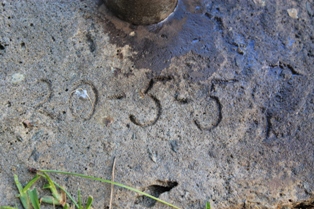 If they ever pull the board out I’ll get over half of the National Champions on the board and a bit over a third of the World Champions. They started with me and they still come back. One young man, his father still lives just up the road, a world sailor in Moths he was, he’s now an Olympic coach and Emmett Lazich, whenever he’s around the world doing this and that we always get a Christmas card and it’s “To the old coach” and he finishes “From the young coach.”. Eileen treasures these.
If they ever pull the board out I’ll get over half of the National Champions on the board and a bit over a third of the World Champions. They started with me and they still come back. One young man, his father still lives just up the road, a world sailor in Moths he was, he’s now an Olympic coach and Emmett Lazich, whenever he’s around the world doing this and that we always get a Christmas card and it’s “To the old coach” and he finishes “From the young coach.”. Eileen treasures these.
In another three years I will have been a Life Member of BYRA for fifty years. We got back into the sailing when we moved here and have done so for fifty four years; if you go and look at the old Hill’s hoist clothes line out the back you’ll see we inscribed this in the cement when we first moved in. That would be historic!
And the Ocean Youth Club?
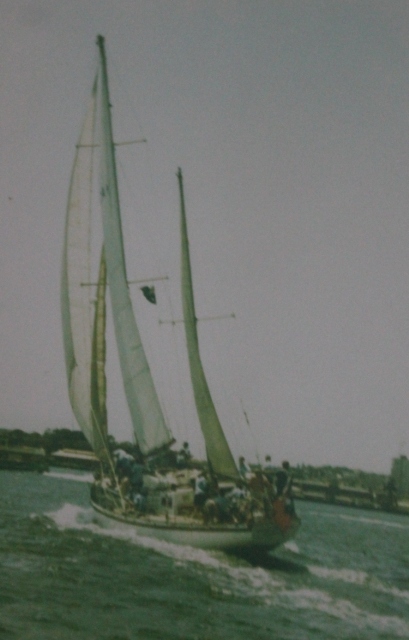 I got involved with the young people and a very good friend of mine involved with the Ocean Youth Club of Australia, we had a club here, suckered me in because I was on the training committee of Sailing NSW, and spent 25 years on there before I retired. With the Ocean Youth Club, which was a very successful club, we took all the leftover and lazy out on a beautiful 77 foot, 22.8 metres ocean going ketch, the Sir Thomas Sopwith. They built them in the UK and they were building new ones and our president of the club here went over there and got one for nothing! We only had to pay for it to be shipped out. Ned Lloyd shipped it out for nothing as deck cargo. I was co-opted then into the crew and Don Gillies, a very well known man in sailing, was the skipper and I was the bosun. I then served in every rank up to Ocean Master under him.
I got involved with the young people and a very good friend of mine involved with the Ocean Youth Club of Australia, we had a club here, suckered me in because I was on the training committee of Sailing NSW, and spent 25 years on there before I retired. With the Ocean Youth Club, which was a very successful club, we took all the leftover and lazy out on a beautiful 77 foot, 22.8 metres ocean going ketch, the Sir Thomas Sopwith. They built them in the UK and they were building new ones and our president of the club here went over there and got one for nothing! We only had to pay for it to be shipped out. Ned Lloyd shipped it out for nothing as deck cargo. I was co-opted then into the crew and Don Gillies, a very well known man in sailing, was the skipper and I was the bosun. I then served in every rank up to Ocean Master under him.
We had a crew of four and would take 14 with us; two watches of seven each. We had this boat for 15 years. I spent a lot of weekends taking them on trips up and down the coast. We couldn’t get any sponsors despite all our hard work, so she was put on the market and attracted a sponsor. Ken Berkley, and Theo Taylor (his company waterproofed the Harbour tunnel) were our main sponsors.
The Ocean Youth Club have gone the full circle because the Sir Thomas Sopwith has been rebuilt. The boat was a wreck; Don Gillies and I brought it up and put it on a mooring and a fellow bought it, she doesn’t race, and it’s owned now by David Edwards and his wife, wonderful people.
You’ve certainly met a lot of interesting people.
I have and this has moulded me into who I am J L Gordon, and I give no quarter now, at my age, being in my eighties; if they don’t want to listen to me; no problem, I’m happy.
The children that aren’t sailing now, what are they missing out on?
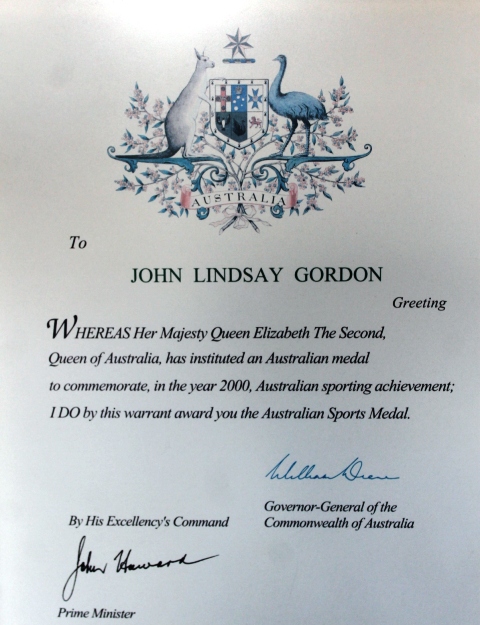 They’re missing out on a skill very associated with decision making; do I tack or don’t I tack, independent thinking and making decisions. That’s how I got into Sailability.
They’re missing out on a skill very associated with decision making; do I tack or don’t I tack, independent thinking and making decisions. That’s how I got into Sailability.
I’m dropping a name, and she’s written two books, in each of these there’s a ‘John’ mentioned who is me, and the author of these works is Kay Cottee. She rang me up one day and asked me “what do you know about Sailability?” and, “we haven’t got a Sailability club in Pittwater” and there was only a couple at that stage, we were the third one, and she said “I reckon we should have one”.
Kay had just been around the world at this stage, so I said “do you want me to give you references for patrons?’ and she said “no, I want you to get off your bum and start one!” and “if you say no, when my books are reissued, I’ll rip your name out.”
So what do you do… she’s a beautiful lady. I ran with John Anderson, an Olympic gold medallist, at the Institute of Sport at Narrabeen, 15 programs, for the Kay Cottee Sailing Encouragement Program. So I have 14 shirts from each year for this, the other ended up in the rag bag. I’m still an honorary member of Sailability at Gosford and go up there occasionally. I’m still coach at Penrith Lakes Sailability. One of my jobs when on the NSW Sailing Committee was to accredit clubs as they came online and I did this for about 12 clubs. I still go up once a month to Penrith Lakes for the ‘come and try’ and the Monday is the club day. The head instructor at Penrith Lakes is John Smith, whom I trained originally.
In the year 2000, when they had the Olympics here, old Howard commissioned the Governor General to petition Queen Elizabeth for an Australian Olympic medal for ‘services to yachting’ and I received that. There were only two thousand issued and sailing only got fifty. They had to do something for all those people in the background. I was nominated. The Governor General wears one too; she was a fast bowler, in cricket. I can put ASM after my name should I want to or if I’m doing anything in yachting. My little yacht I have now floats down there on Pittwater, it’s still fully set up for snoozing and cruising.
What made you decide to move to Mona Vale and Bungan Beach?
We had a couple of friends up here and came up to visit them and they weren’t home. So we had a look around and Eileen said “this is a lovely area”. When we bought the place I got the windows lowered so I can sit here and I’ve just been watching the Wednesday afternoon twilight sailing race. My son is a member of Prince Alfred; he’s got a flash yacht, bigger and better then mine. Eileen was the Chief Chemist at the Research Institute at North Sydney, and I was working at North Sydney Tech., so this was our beach shack originally. At any rate, we came out here, saw the view, which we’ve lost now, but over that way you still have some facing Pittwater. That pine tree there is older then this house; has been on this block since before we built this house.
What is your favourite place in Pittwater and why?
Pittwater itself; Broken Bay’s closed waters. My little boat was fitted up for single hand sailing after I had my stroke. She sat on her mooring for two years. I got over my stroke because I thought ‘this is the end of my life and I want to be able to get out on my boat’. The sailing on Pittwater is why I love it; look at it, it’s just a beautiful place. We’re lucky to have the National Park there. It’s such a beautiful relaxing place.
What is your ‘motto for life’ or a favourite phrase you try to live by?
When you get to my age and you look back, God has granted me 86 years, and I hang on for every day I can get so; If things are getting bad, stand up, brush all the muck off you, climb out of the hole, and take it day by day and keep a smile on you face. I say that to young people; keep a smile on your face and take it day by day.
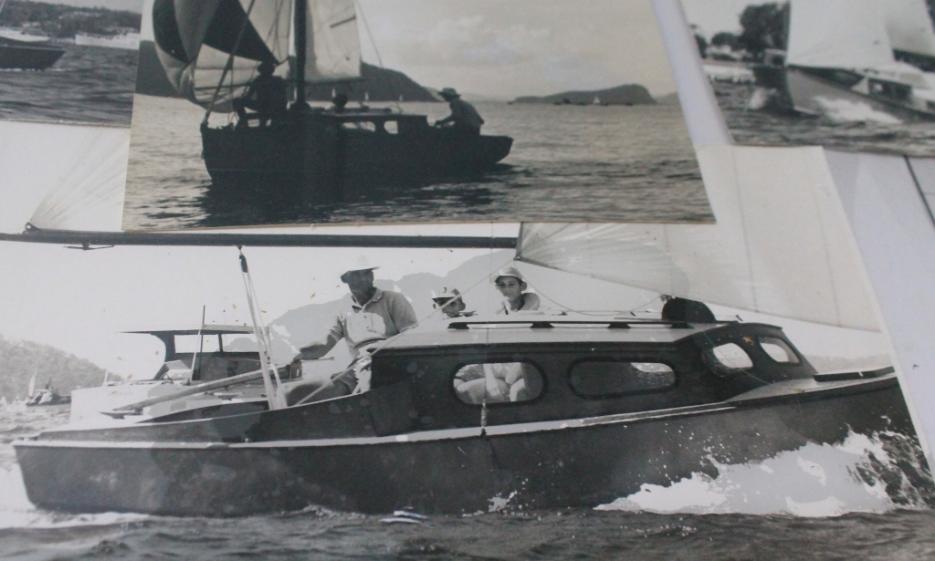
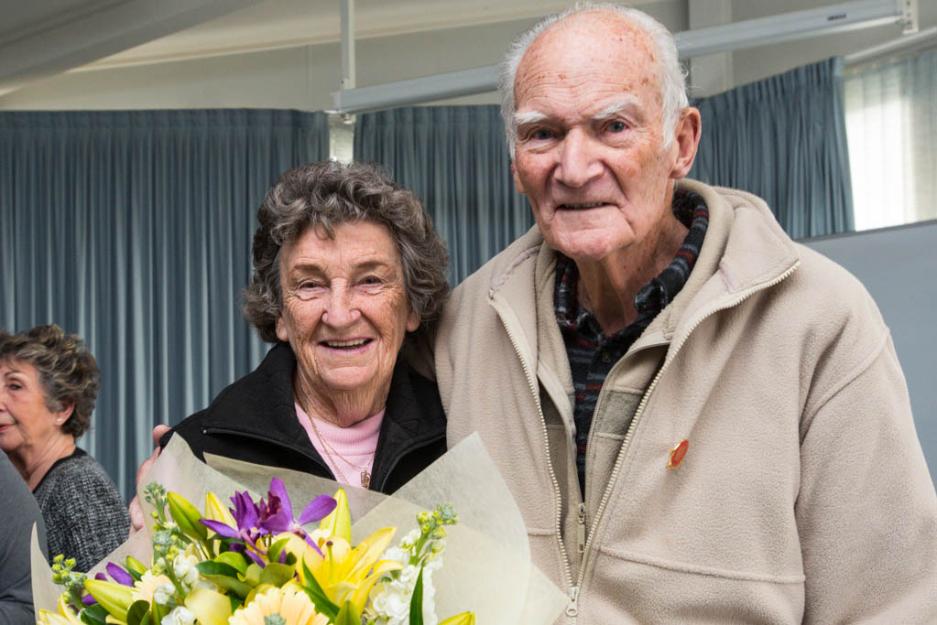
John and Eileen Gordon. Photo and In Text Portrait of John by Michael Mannington, 2013.
